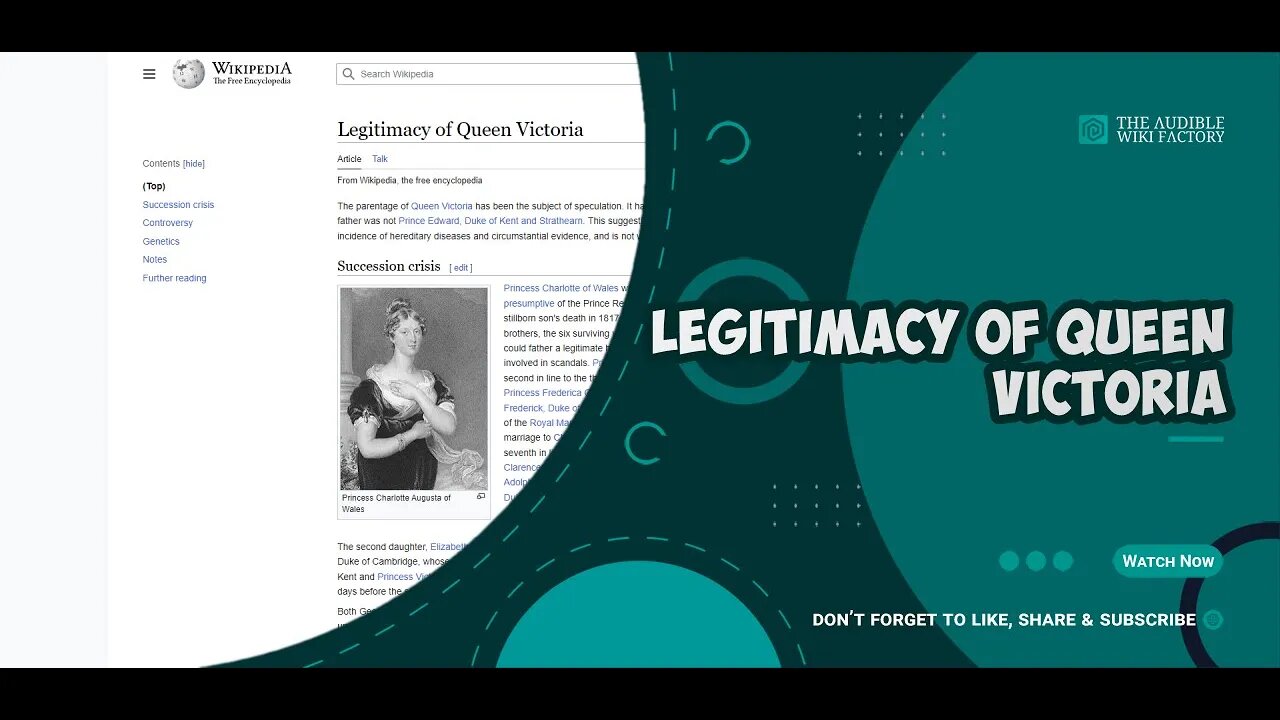Premium Only Content

The parentage of Queen Victoria has been the subject of speculation. It has been suggested that
The parentage of Queen Victoria has been the subject of speculation. It has been suggested that her biological father was not Prince Edward, Duke of Kent and Strathearn. This suggestion has largely centred on the familial incidence of hereditary diseases and circumstantial evidence, and is not widely believed.
SUCCESSION CRISIS
Princess Charlotte of Wales was the only daughter and heiress presumptive of the Prince Regent (later King George IV). Her and her stillborn son's death in 1817 set off a race between the Prince Regent's brothers, the six surviving younger sons of King George III, to see who could father a legitimate heir. Some of the brothers had been previously involved in scandals. Prince Frederick, Duke of York and Albany, the second in line to the throne, was amicably separated from his wife, Princess Frederica Charlotte of Prussia. The sixth son, Prince Augustus Frederick, Duke of Sussex, had contracted two marriages in contravention of the Royal Marriages Act 1772 (as had the Prince Regent before his marriage to Charlotte's mother). Three brothers, the third, fourth and seventh in line to the throne, married in 1818: Prince William, Duke of Clarence; Prince Edward, Duke of Kent and Strathearn; and Prince Adolphus, Duke of Cambridge. The fifth son, Prince Ernest Augustus, Duke of Cumberland, was already married but had no living children at the time.
The Duke of Clarence married Princess Adelaide of Saxe-Meiningen. Though he had been able to father ten illegitimate children with Dorothea Jordan, an earlier mistress, none of his children by his wife survived childhood. The second daughter, Elizabeth, lived the longest, being born on 10 December 1820 and dying on 4 March 1821. The next son to produce an heir was the Duke of Cambridge, whose son George was born on 26 March 1819. He would be displaced two months later by the birth of a daughter to the Duke of Kent and Princess Victoria of Saxe-Coburg-Saalfeld, his wife. Their first and only child was Princess Victoria. She was born on 24 May 1819, just three days before the son of the Duke of Cumberland, also called George.
Both George III and the Duke of Kent died in January 1820. The Prince Regent became George IV and Victoria was third in line to the throne after her uncles, the Duke of York and Duke of Clarence (the future William IV). She would ultimately take the throne as Queen Victoria in 1837.
CONTROVERSY
Rumours about Victoria's parentage centred on a controversial Irish soldier and adventurer called Sir John Conroy who was her mother's private secretary and the comptroller of her household. The Duchess of Kent was the same age as Conroy, whereas she was nineteen years younger than her husband; the court gossiped openly about their relationship. After the Duke's death, Conroy assumed a parental role towards Victoria that she bitterly resented. This caused a near permanent rift between Victoria and her mother, as well as between the Duchess and her brother-in-law, William IV. Conroy expected that when Victoria became queen he would be made her private secretary, but instead one of her first acts as monarch was to dismiss him from her household.
The belief that the Duchess and Conroy were lovers was widespread. When asked by Charles Greville whether he believed they were lovers, the Duke of Wellington replied that he "supposed so". The Duke later recounted a story that when Victoria was young she had caught Conroy and the Duchess engaged in what were diplomatically called "some familiarities". Wellington reported that she told Baroness Louise Lehzen, who told her close ally, Madame de Späth, who confronted the Duchess about her behaviour. According to Wellington, the Duchess of Kent was furious and promptly dismissed de Späth. Victoria, when queen,...
LINK TO ARTICLE: http://en.wikipedia.org/wiki/Legitimacy_of_Queen_Victoria
TAGS: Legitimacy of Queen Victoria, Urban legends, Queen Victoria
#GeneralKnowledge #AudibleWikiFactory #Audible #Wikipedia #LegitimacyofQueenVictoria
-
 41:13
41:13
The Audible Wiki Factory
2 years agoThe Oktoberfest is the world's largest Volksfest, featuring a beer festival and a travelling
443 -
 LIVE
LIVE
Barry Cunningham
3 hours agoPRESIDENT TRUMP IS THE TROLLER-IN-CHIEF AND MORE BREAKING NEWS!
3,523 watching -
 LIVE
LIVE
GamerGril
1 hour agoGG BINGO | 💕 The Beast Inside 💕 | Not Even Scared
1,922 watching -
 2:02:10
2:02:10
Akademiks
2 hours agoWar in RAT-LANTA. Young Thug vs Gunna vs Ralo vs YSL MONDO. Who Will Le Bebe Pick. FINAL CRASHOUT!
20.7K7 -
 1:13:36
1:13:36
Jeff Ahern
2 hours ago $1.62 earnedThe Sunday Show with Jeff Ahern
5.41K4 -
 LIVE
LIVE
GoodLifeGaming
4 hours ago🔴LIVE - TARKOV PVP SOLO LEARNING - 2 MIL STASH - LEVEL 14 - WOODS LOOT RUNS - POSSIBLE QUESTING
39 watching -
 29:16
29:16
The Shannon Joy Show
1 day ago🔥🔥The Extraordinary Healing POWER Of The Sun - With Dr. Chad Walding🔥🔥
15.6K4 -
 LIVE
LIVE
KammieKamz
1 hour agoKamz & Lydia take on REBIRTH ISLAND RANK to diamond *Agent of Chaos 😏💨 | Warzone Queen on Rumble”
34 watching -
 LIVE
LIVE
FusedAegisTV
6 hours agoHollow Knight Silksong Waiting Room ~~ pt. 2
63 watching -
 15:27
15:27
Sideserf Cake Studio
1 day ago $14.20 earnedThis K-Pop Demon Hunters CAKE is how it's done, done, done!
57.5K15